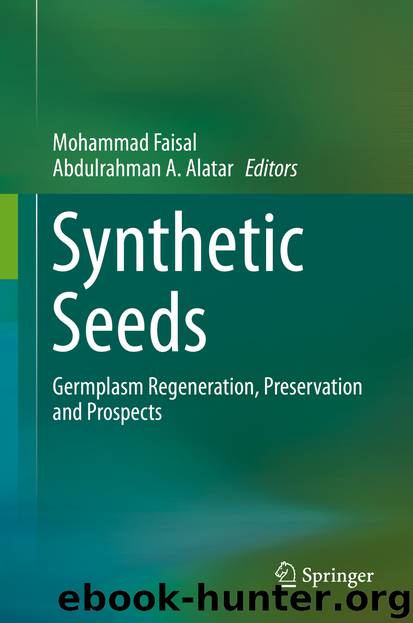Synthetic Seeds by Mohammad Faisal & Abdulrahman A. Alatar

Author:Mohammad Faisal & Abdulrahman A. Alatar
Language: eng
Format: epub
ISBN: 9783030246310
Publisher: Springer International Publishing
2 Previous Experimental Experiences
Cryptocoryne lutea and Rotala rotundifolia were previously studied in order to individuate a suitable protocol for micropropagation (Micheli et al. 2006). The shoot proliferation was obtained in Linsmaier and Skoog (LS) medium (Linsmaier and Skoog 1965) enriched with 0.5 mg l−1 naphthalene acetic acid (NAA) and two concentrations of 6-benzylaminopurine (BAP) (1 and 4 mg l−1) (Note 1). In all species, the medium containing 4 mg l−1 of BAP resulted in higher multiplication rates (Micheli et al. 2006). The color of the proliferated shoots was always light green in Cryptocoryne lutea and dark green in Rotala rotundifolia, proper and typical colors of the two species. In all cases the proliferation was accompanied by root formation. The lower concentration of BAP (1 mg l−1) induced a higher number and length of roots (Micheli et al. 2006). In Cryptocoryne lutea the roots appeared fleshy, while in Rotala rotundifolia they were fibrous. In general, considering also the results obtained during the acclimation, with two substrates (natural and commercial substrates), the conclusion was that the application of 4 mg l−1 of BAP was more productive because it induced a higher number of shoots, while the substrate poor in cytokinins could be employed to obtain a better quality of rooting (Micheli et al. 2006).
The high rooting capacity of shoots of Cryptocoryne lutea and Rotala rotundifolia induced to assume that nodal microcuttings could be able to develop a whole plantlet (conversion) without inductive treatments and can be employed to produce synthetic seeds of Cryptocoryne lutea and Rotala rotundifolia. In fact, subsequent studies confirmed that the synthetic seeds, obtained from the encapsulation of microcutting showed 100% of conversion in both species after sowing in aseptic conditions (data not published).
Download
This site does not store any files on its server. We only index and link to content provided by other sites. Please contact the content providers to delete copyright contents if any and email us, we'll remove relevant links or contents immediately.
| Anatomy | Animals |
| Bacteriology | Biochemistry |
| Bioelectricity | Bioinformatics |
| Biology | Biophysics |
| Biotechnology | Botany |
| Ecology | Genetics |
| Paleontology | Plants |
| Taxonomic Classification | Zoology |
Sapiens: A Brief History of Humankind by Yuval Noah Harari(14320)
The Tidewater Tales by John Barth(12626)
Mastermind: How to Think Like Sherlock Holmes by Maria Konnikova(7278)
Do No Harm Stories of Life, Death and Brain Surgery by Henry Marsh(6905)
The Thirst by Nesbo Jo(6879)
Why We Sleep: Unlocking the Power of Sleep and Dreams by Matthew Walker(6655)
Life 3.0: Being Human in the Age of Artificial Intelligence by Tegmark Max(5516)
Sapiens by Yuval Noah Harari(5323)
The Longevity Diet by Valter Longo(5042)
The Body: A Guide for Occupants by Bill Bryson(5029)
The Rules Do Not Apply by Ariel Levy(4910)
The Immortal Life of Henrietta Lacks by Rebecca Skloot(4550)
Animal Frequency by Melissa Alvarez(4428)
Why We Sleep by Matthew Walker(4394)
The Hacking of the American Mind by Robert H. Lustig(4339)
Yoga Anatomy by Kaminoff Leslie(4333)
All Creatures Great and Small by James Herriot(4271)
Double Down (Diary of a Wimpy Kid Book 11) by Jeff Kinney(4240)
Embedded Programming with Modern C++ Cookbook by Igor Viarheichyk(4141)
